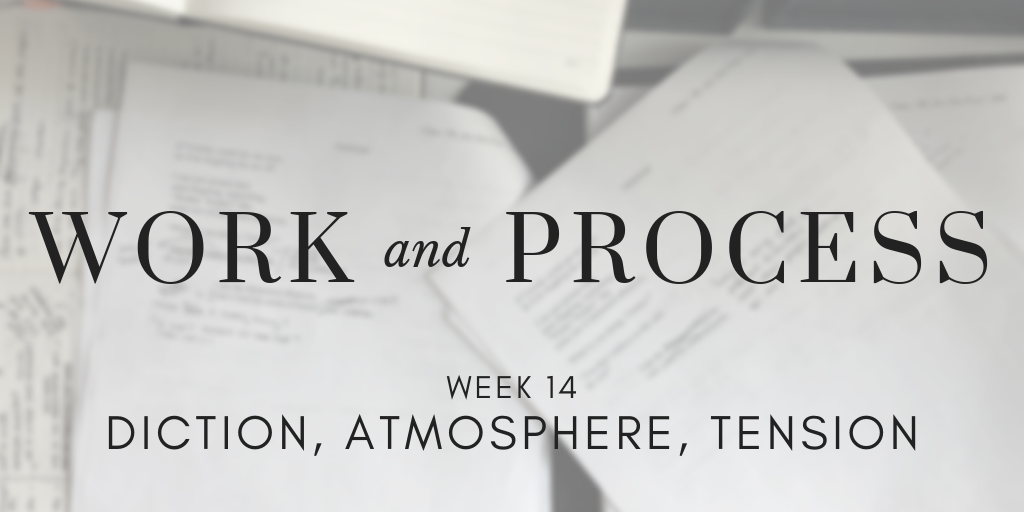|
Welcome back, fellow creators, to our second week of posts about diction a.k.a. word choice. If you’re just arriving, please feel free to check out last Sunday’s discussion of diction and character, although you can also just forge ahead into today’s topic as well: diction, atmosphere, and tension. To start, I’d love to talk about two diction-related concepts: denotation and connotation. Generally, I think of denotation as the actual dictionary definition of a word, precise, and important for conveying your primary meaning. For example, the word “dog” denotes a four-legged mammal of the genus Canis, domesticated by humans over tens of thousands of years. Denotation tends to be important and effective in its to-the-point-ness, but also, for our storytelling purposes, a little uninteresting. It’s connotation, I think, where things get fun. Connotation is the collection of the numerous other meanings, feelings, and associations that a word can evoke. I picture these meanings like a cloud, all hovering around the actual definition, all conjured every time you use the word. The word “dog,” therefore, can connote loyalty, or obedience, or unpleasantness. A character can be dogged in her pursuits if she’s particularly persistent. A character can dog a person’s heels if they’re following them closely. In storytelling, if you choose your words carefully, you can use their connotations to create both atmosphere and tension in your narrative in an efficient way. Diction to Build Atmosphere When I was teaching English, I had my students define atmosphere as “mood,” and I’d like to expand on that a bit here. I think of atmosphere as the feeling a reader gets from a passage (eerie, exuberant, foreboding, menacing, relaxed, etc.) the same way you’d get a feeling from walking into any real life setting (a crumbling house, a sun-dappled glen, a field beneath the fireworks on Fourth of July). While you can absolutely spend paragraphs or even pages creating the atmosphere of a particular setting (with denotation), it’s often more expedient and effective to build it in a single sentence. As an example, let’s take this sentence from Roshani Chokshi’s YA fantasy, The Star-Touched Queen: “The archives were cut like honeycombs and golden light clung to them, dousing every tome, painting, treatise and poem the soft gold of ghee freshly skimmed from boiling butter” (p. 11). On the one hand, this is a description of hexagonal-shaped, sunlit rooms filled with books and paintings. That’s denotation. On the other, each of these words evokes a certain mood in addition to illustrating the archives and their contents. “Clung,” “dousing,” and “skimmed” are all words that connote a certain closeness, a certain feeling of contact with the skin. “Honey” has a similar tactile stickiness, and “butter” gives you that oily, coating sort of feeling. This is the connotation. The archives, then, are a warm and opulent (“golden,” “soft gold”) place, but close, too, almost oppressive, almost too much, almost cloying in their richness. With a few well-chosen words, Chokshi builds an atmosphere you can almost feel. Diction to Build Tension As with character and atmosphere, diction can also create tension. In a chapter of the Secret Project I was working on yesterday, a character uses the word “carmine” to describe another character’s traits: “his carmine eyes always darting back and forth between us.” This word choice gave me pause--it’s a curious word, I think, not a word I’d use myself, generally, and not a word I hear every day, and so it kind of calls attention to itself. Often, I want the language in my books to serve the story, to be invisible, in a way, noticeable only in how effective the story is, so “carmine” was, for me at least, an odd choice. But it’s also the one that fit. In definition, “carmine” is a fancy way of saying “red.” As per last week’s post on fancy vs. plain language, it follows that this character, who’s pretty well-read, would use a highfalutin word here, although there are a number of other words he could have used instead: garnet (evoking jewels, sharpness, sparkle), mahogany (evoking a more brownish hue, wood, richness), cinnamon (evoking spice, warmth), etc. “Carmine,” however, evokes something nastier. Carmine is a pigment made from grinding insects into powder, so it’s related to 1) death, 2) the act of crushing and pulverizing, and 3) creepy crawlies. (It’s also the name of a Batman villain, Carmine Falcone.) These associations all help to build tension between my point-of-view character and this man with the reddish-brown eyes. Although we’re just getting introduced to this guy, from this word alone, we can intuit that there’s something off about him, something unsettling and perhaps even dangerous. That’s why I love connotation. I think if it’s used well, then your diction can do double-duty: tell your reader’s what’s happening in the scene and build background elements like atmosphere and tension that are more felt than said, but are nonetheless integral to the telling of a good story. Next week: DICTION & THEME. Okay, one more week of word choice to go, and it’s about how word choice can build theme! Make a scene next Sunday at tracichee.com and/or post your own responses with the hashtag #workandprocess. Huzzah! <3 Work and Process is a year-long journey of exploring and reflecting on the artistic process, craft, and working in a creative field. Each Sunday, I’ll post some thoughts, wonderings, explanations, and explorations on writing and creativity, and by the end of it, I hope to have 52 musings, examinations, meanderings, discoveries, bits of joy or inquisitiveness or knowledge to share. In each post, I’ll also include a topic for the following week, so if you happen to be inspired to question/wonder at/consider your own work and process, you’re welcome to join me. We’ll be using the #workandprocess hashtag across all social media platforms, and I hope we find each other to learn and connect and transform on our creative wanderings. Comments are closed.
|
ARCHIVES
February 2024
CATEGORIES |


 RSS Feed
RSS Feed